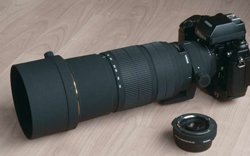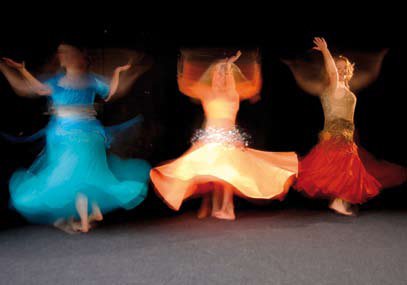articles/Cameras/nikond200-page5
Nikon D200 - part 5 of 1 2 3 4 5 6
by Mike McNamee Published 01/06/2006

On the Field We have tested the D200 with many more frames than we would normally, most of them on cricket. On three occasions we shot 160, 422 and 550 frames using lenses up to 600mm focal length, equivalent to 900mm in 35mm terms. We shot in sunshine and in rain just as rainstopped- play at ISO ratings from 100 to 800.
Lens combinations we tried included the 300mm f4 Nikkor, the TC201 2x teleconverter (manual focus) and the Sigma f2.8 120-300mm zoom (shown below). All worked very well on the D200 despite the age of the TC201. Using the "Non-CPU" menu facility we were able to dial in the lens parameters so that the exposure meter worked as though a true CPU lens was connected, even as far as the meta data.
The focussing facilities of the D200 are very comprehensive.
There are four modes manually switchable on the back of the camera and with another three on the front you have eight options excluding the manual focus option. In addition you may also set trap focus (which prevents the shutter from firing unless the focus light is "on") and a number of other options via the rear screen menu. The main options are listed in the table.

In practice we dabbled with various options but, in the time available, we concluded that there was much more to learn and exploit. When you are trying to freeze Australian pace bowlers you need all the help you can get (as does the batsman!). The ability of the dynamic focus to pick up and follow a subject as it moves around the field of view is actually quite spooky and we look forward to trialling it in detail when our own D200 arrives.
The ultimate test is going to be following an incoming bowler to see if he can get past the umpire without the focus fixing on the official rather than the bowler. It is a big ask but we think it might just do it!
Depending on how you set up your custom menu, autofocus will either slow things down or shoot out of focus images. To give the D200 enough time to catch up and focus, you set CUSTOM > Autofocus > AF-C Mode Priority (a1) to "FPS + AF" or "Focus." The default position of "FPS" means it just keeps on shooting regardless of having focus confirmation. FPS + AF means it compromises, and Focus means it waits for each shot to be in perfect focus before continuing. With these settings, the frame rate invevitably slows but your percentage of infocus shots increases.
In AF-S mode the D200 only shoots when it's in focus. AF-S mode is not a good option for use with moving subjects, since it focuses once and stays there. Hence you get the first frame in focus, and nothing else if the bowler moves. Setting CUSTOM > AF-S mode Priority (a2) to Shutter at fast frame rates is not at all clever, the D200 then shoots as soon as you press the button and keeps going without ever bothering to focus again, even if it was out of focus at the start.
Please Note:
There is more than one page for this Article.
You are currently on page 5
- Nikon D200 page 1
- Nikon D200 page 2
- Nikon D200 page 3
- Nikon D200 page 4
- Nikon D200 page 5
- Nikon D200 page 6
1st Published 01/06/2006
last update 09/12/2022 14:56:59
More Cameras Articles
There are 25 days to get ready for The Society of Photographers Convention and Trade Show at The Novotel London West, Hammersmith ...
which starts on Wednesday 14th January 2026





